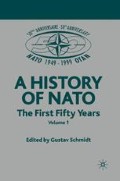Abstract
As the North Atlantic Treaty Organization (NATO) celebrates its fiftieth anniversary, NATO enlargement continues to be a divisive analytical issue. This paper seeks to promote discussion as to who gains, and who loses, from the NATO enlargement process. To assess the implications of NATO enlargement, I look at four specific cases: the United States, Western Europe, the three new members, and Russia. My central conclusion is that each of the four groups emerged with real or perceived gains from NATO enlargement. However, the gains may not be what was initially expected and the long-term implications for NATO and the future of European security are cause for serious concern.
Access this chapter
Tax calculation will be finalised at checkout
Purchases are for personal use only
Preview
Unable to display preview. Download preview PDF.
Notes
For further discussion, see Michael E. Brown, et al (eds.), America’s Strategic Choices (Cambridge: MIT Press, 1997), especially chapters by Barry Posen and Andrew Ross, and Michael Mastanduno. Also see comments on internal containment of Germany by Zbigniew Brzezinski in Andrej Sylinski, ‘Brzezinski: Enlarged NATO Contains Germany’s Power in Europe.’ Associated Press, 7 December 1997.
For detailed discussion see Theodore Couloumbis, The United States, Greece, and Turkey: The Troubled Triangle (New York: Praeger, 1983) and S. Victor Papacosma, ‘Greece and NATO,’ in NATO and the Mediterranean, ed. by Lawrence S. Kaplan, Robert W. Clawson, and Raimondo Luraghi (Wilmington, DE: Scholarly Resources, 1985).
See Sean Kay, ‘The New NATO and the Enlargement Process,’ European Security, Vol. 614: No. 2 (Winter 1997): pp. 1–16.
See Christopher Layne, ‘Why Die for Gdansk?’ in Ted Galen Carpenter and Barbara Conry (eds.), NATO Enlargement: Illusions and Reality (Washington, D.C.: The CATO Institute Press, 1997), pp. 53–70.
For discussion of the strengths and weaknesses of each new NATO member, see Andrew Michta (ed.), America’s New Allies (Seattle: University of Washington Press, 1999).
Peter W. Rodman, ‘The Fallout from Kosovo,’ Foreign Affairs, Vol. 78: No. 4 (July/August 1999): p. 48.
Editor information
Editors and Affiliations
Copyright information
© 2001 Palgrave Macmillan, a division of Macmillan Publishers Limited
About this chapter
Cite this chapter
Kay, S. (2001). NATO Enlargement: Who Gains? Who Loses?. In: Schmidt, G. (eds) A History of NATO — The First Fifty Years. Palgrave Macmillan, London. https://doi.org/10.1007/978-1-349-65576-2_15
Download citation
DOI: https://doi.org/10.1007/978-1-349-65576-2_15
Publisher Name: Palgrave Macmillan, London
Print ISBN: 978-1-349-65578-6
Online ISBN: 978-1-349-65576-2
eBook Packages: Palgrave Political & Intern. Studies CollectionPolitical Science and International Studies (R0)

